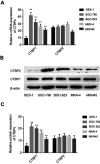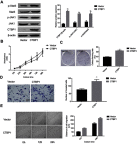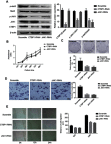C-terminal of E1A binding protein 1 enhances the migration of gastric epithelial cells and has a clinicopathologic significance in human gastric carcinoma
- PMID: 31308691
- PMCID: PMC6616302
- DOI: 10.2147/OTT.S203479
C-terminal of E1A binding protein 1 enhances the migration of gastric epithelial cells and has a clinicopathologic significance in human gastric carcinoma
Retraction in
-
C-Terminal of E1A Binding Protein 1 Enhances the Migration of Gastric Epithelial Cells and Has a Clinicopathologic Significance in Human Gastric Carcinoma [Retraction].Onco Targets Ther. 2021 Mar 10;14:1857. doi: 10.2147/OTT.S309723. eCollection 2021. Onco Targets Ther. 2021. PMID: 33732002 Free PMC article.
Abstract
Background: Recent studies have claimed that the C-terminal of E1A binding proteins (CtBPs) influence tumorigenesis through participating in cell signal transduction in various human tumors. However, the detailed expression profiles of CtBP isoforms in human gastric cancer (GC) and the molecular mechanisms of CtBP involvement in tumor cell phenotypes warrant further investigation.
Materials and methods: The expression of CtBPs in GC cell lines and a human gastric epithelial cell line were explored via RT-qPCR and Western blotting assays. Moreover, the expression profiles of CtBPs in GC and histologically noncancerous tissues were explored by immunohistochemistry. To explore the effects of CtBP1 on the metastatic phenotype in GC, gastric epithelial cells were transfected with a eukaryotic expression plasmid to overexpress CTBP1, and the endogenous CtBP1 or JAK1 in GC cells was silenced through an RNA interference (RNAi) method. These transfections were validated via Western blotting, and the activation state of the JAK1/Stat3 signaling pathway was also explored via Western blotting. Furthermore, the malignant phenotype of GC cells was evaluated via a Cell Counting Kit-8 (CCK8) assay, colony formation assay, transwell assay, and wound-healing experiment.
Results: Our data revealed that the expression of CtBP1, but not CTBP2, was upregulated in 102 GC tissue samples compared with 98 noncancerous tissue samples, and the elevated expression level of CtBP1 was notably associated with distant metastasis. CTBP1 modulated cell migration and invasion through the JAK1/Stat3 signaling pathway in gastric epithelial cells. In addition, genetic silence of CtBP1 expression in GC cells notably constrained cell proliferation, invasion and migration abilities through inhibiting the activation of the JAK1/Stat3 pathway in GC cells.
Conclusion: Our data reveal that the knockout of CtBP1 notably constrains distant metastasis in GC through the JAK1/Stat3 pathway, suggesting that targeting CtBP1 is a practical anti-tumor approach to restrain tumor progression in GC.
Keywords: C-terminus of the E1A binding proteins; Janus Kinase 1; gastric cancer; signal transducer and activator of transcription 3.
Conflict of interest statement
The authors report no conflicts of interest in this work.
Figures




References
-
- Koessler T, Roth A, Cacheux W. [Early gastric cancer: epidemiology, diagnostic and management]. Rev Med Suisse. 2014;10(431):1118–1122. - PubMed
-
- Schaeper U, Subramanian T, Lim L, Boyd JM, Chinnadurai G. Interaction between a cellular protein that binds to the C-terminal region of adenovirus E1A (CtBP) and a novel cellular protein is disrupted by E1A through a conserved PLDLS motif. J Biol Chem. 1998;273(15):8549–8552. doi:10.1074/jbc.273.15.8549 - DOI - PubMed
Publication types
LinkOut - more resources
Full Text Sources
Research Materials
Miscellaneous

